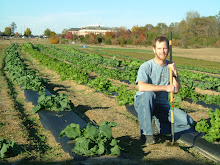
This is my main field experiment in S. Tallassee, AL.
This field of rye is the residue of my winter cover crop, measuring about 3.5 tons per acre.

It was killed without the use of herbicides using crimp-and-roll equipment, which is why all the rye is lying in the same direction.
In order to plant in a no-till field, all the residue must lie in the same direction so that the stalks don't clog up the tillage equipment.

This is a decomposition experiment.
Nylon mesh litterbags are packed with samples of organic mulches, then either buried (to represent conventional tillage) or placed on the surface (to represent no-till).

The bags are retrieved periodically and the contents are analyzed for mass and nutrient content.
Knowing the different nutrient release rates between conventional and no till will inform farmers about how and when nutrients are released from the mulches and available to the plants.


No-till is known to conserve soil by limiting erosion, as well as conserving soil moisture, which means less irrigation. Nutrients are also released more slowly when no-till is practiced.
 It was killed without the use of herbicides using crimp-and-roll equipment, which is why all the rye is lying in the same direction.
It was killed without the use of herbicides using crimp-and-roll equipment, which is why all the rye is lying in the same direction.

